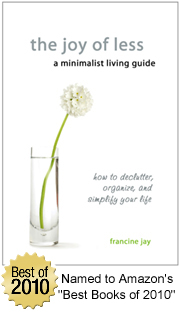Really taking up the challenge of minimalism
Oct 19, 2011 · 5 minute read · Commentsminimalism
Yesterday, I talked about use of time. Today, I am talking about space.
I have too much stuff.
I know that. I’ve known that for years. I’ve not been happy about it. But I’ve also not been happy about getting rid of my stuff. When I got married, I had to get rid of probably half of my stuff, to make space for Abby to move in, but I did not part with them happily.
And I still have too much stuff. I’ve been promising to get rid of more, but have dragged my feet on the project.
This time is different.

Front cover of The Joy of Less by Francine Jay
My promise
Today I made a promise to Abby, and now I’m making a promise in public, to complete the project. Yes, I know, there are claims that one should keep one’s goals to oneself, but I’m ignoring them this time.
Objectively, I know all the reasons not to have a lot of stuff.
Yes, I’m familiar with George Carlin’s great monologue:
And yes, I’ve read Leo Babauta’s book, The Power of Less, which did help me make radical changes to my life a couple of years ago.
Although I’ve made much progress in the past two to three years, it was never enough. We got rid of over a thousand books (as I mentioned in yesterday’s post), through selling on Amazon and donating to various sources. We got rid of most of my LPs, started getting rid of some of my CDs and DVDs. Etc. But there is still a lot left. Not only books, music, movies, but also computer parts, cables, old pens, unused small appliances, etc.
Abby deserves credit for having taken charge of most of the decluttering that we’ve done. Minimalism comes to her much more easily than it does to me. I’m the one who has all that stuff in the basement going unused!
My “pack rat” mentality always lurks around, ready to emerge at any time to defend keeping something. So I never completed the project of really letting go. There was always something to keep that deep down I knew I didn’t really need.
Another book on minimalism
But another book on minimalism has really inspired me to go further with my “decluttering”: Francine Jay’s The Joy of Less, A Minimalist Living Guide.
For some reason, this book’s conversational tone and detailed exploration of why we keep stuff was inspirational to me. I have to confess that some books and web sites on minimalism that I have looked at in the past seemed a bit too manic and preachy, and turned me off. They made minimalism look like some kind of self-righteous game, a competition, a form of reverse-snobbery (“oh, look at me, I have only a hundred possessions!”). Also, they made it sound easy to make the leap to minimalism, and since I find the leap very difficult, I got discouraged. I just didn’t relate well, emotionally, to those sources of advice.
(Often, advice or information or stories meant to be helpful or interesting might fall on deaf ears if the audience does not in a deep way identify with the author. That is an insight I am still in the process of grappling with as I try to figure out how to make my blog maximally useful to you, my reader!)
Helpful insights and ideas
Here are just a few of the helpful ideas from the book.
What stuff is
To begin, the author classifies stuff as one of the following:
- useful
- beautiful
- emotional
Classification is helpful because it enables us to reflect on the why of having something, and distinguish different functions.
You are not what you own
A powerful message, because often we have stuff just because someone else has it or because we want to show off, whether through unnecessary furniture or decorations or even a large book collection (I plead guilty to the latter in the past).
We are what we do, now; not what we have to remind us of what we did (I used to keep around a bunch of trophies that I finally admitted were really pointless to hang onto).
Less stress and more freedom
The author tells us to think of how carefree and happy we were in college, when we had the least amount of stuff. We were learning, living, having fun. And we were not tied down.
It’s true, though: I do remember a time when I had almost nothing, and that was fine. Strange how things changed.
Space
“Life is the space between our things.” An intriguing image! The author urges us to focus on what we do, rather than what we own.
Enjoy without owning
The author says, “In pursuing a minimalist lifestyle, we need to resist the temptation to recreate the outside world within our abodes.” We can “shift some of our pleasures and activities into the public realm.”
I immediately understand how one can enjoy without owning, because for much of my life I did not own much. Libraries were one way I enjoy plenty without owning. Interestingly, today it is even easier now to enjoy without owning. Having Internet access, we can enjoy the resources from a vast digital world!
Pareto principle
The author invokes the Pareto principle, which she interprets in our context as “we use 20 percent of our stuff 80 percent of the time”. So we could actually get rid of most of what we have and not really miss it!
Conclusion
I highly recommend this book to anyone who is even thinking about decluttering project, however big or small.
As I make major progress on my continuing minimalism project, I’ll write about it!